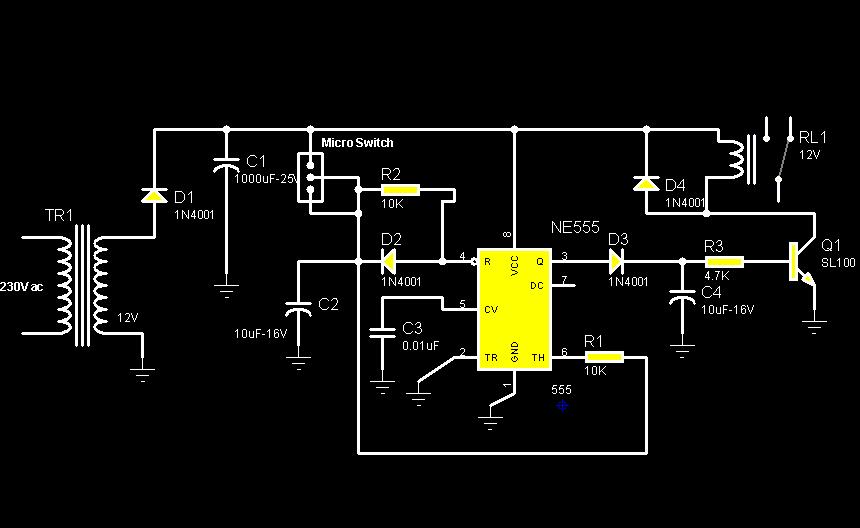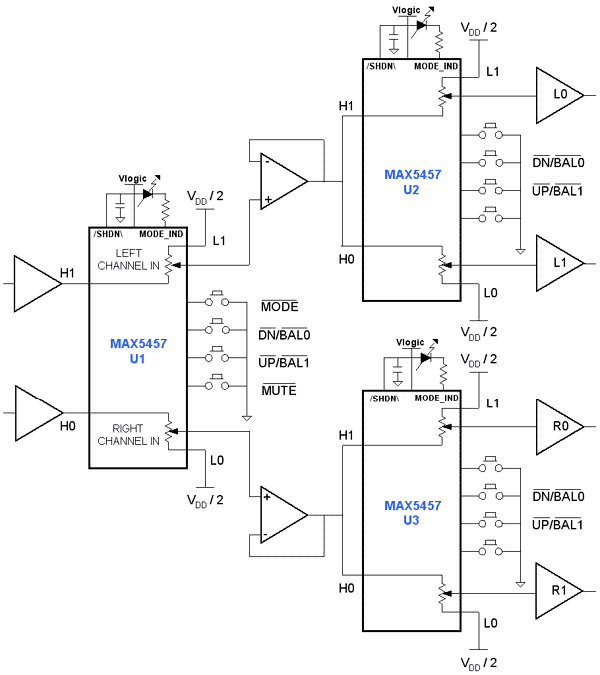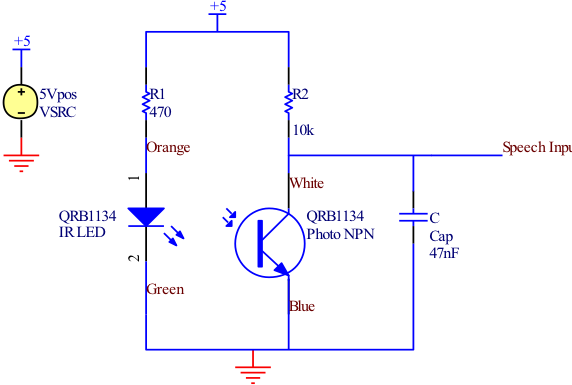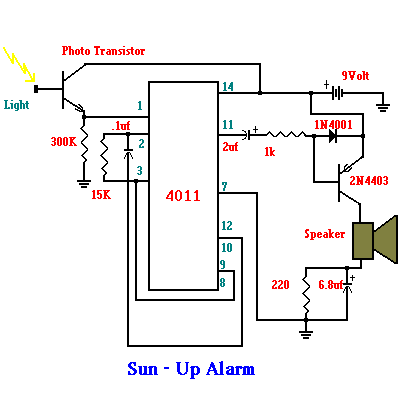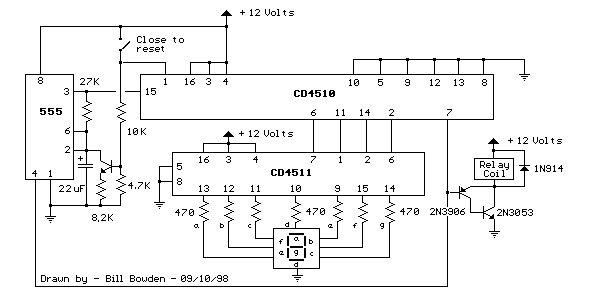
Telephone Ringer Using Timer ICs

The circuit presented utilizes modulated rectangular waves of varying time periods to generate ringing tones akin to those produced by a telephone. It requires four astable multivibrators for operation, implemented using two 556 integrated circuits (ICs). The 556 IC comprises two timers similar to the 555 ICs within a single package. Alternatively, the circuit can be constructed using four individual 555 ICs. The first multivibrator generates a rectangular waveform with a 1-second low duration and a 2-second high duration, which controls the subsequent multivibrator that produces another rectangular waveform. A resistor (R7) is positioned at the collector of transistor (T2) to prevent capacitor (C3) from fully discharging when T2 is conducting. The preset (VR1) must be adjusted so that two ringing tones are audible in the loudspeaker within one second. The remaining two multivibrators are responsible for generating ringing tones corresponding to the ringing pulses produced by the preceding stages. When switch (S1) is engaged, transistor (T1) is turned off, allowing the first multivibrator to commence pulse generation. If this switch is incorporated into the power supply circuit, a longer delay occurs before the ringing initiates upon closing the switch. The circuit also includes a feature for applying a drive voltage to initiate the ringing. It is important to note that the circuit is not designed for direct connection to telephone lines. With suitable drive circuitry connected at the input (across switch S1), this circuit can be utilized with intercom systems, among other applications. Since the ringing pulses are generated internally, only a constant voltage needs to be supplied to the called party for ringing. To mimic the actual telephone ringing, a sequence of a 400 Hz tone is activated: 400 ms on, 200 ms off, 400 ms on, and 2000 ms off, which then repeats.
The circuit functions based on the principle of generating astable multivibrator outputs that can be modulated to create the characteristic ringing tones of a telephone. The use of two 556 ICs allows for a compact design while maintaining the necessary functionality. Each multivibrator's output can be fine-tuned using external components such as resistors and capacitors, which define the timing characteristics of the waveforms produced.
The first multivibrator is configured to provide a base frequency that sets the tempo for the subsequent stages. This is critical as the timing of the low and high states directly influences the audibility and quality of the ringing tone produced. The resistor R7 plays a vital role in maintaining a charge in capacitor C3, thus ensuring that the waveform transitions smoothly and does not lead to abrupt changes that could distort the output sound.
The preset VR1 adjustment allows for customization of the ringing tone frequency, enabling the user to select a tone that is distinct yet recognizable. The final output from the last two multivibrators is designed to replicate the on-off pattern of a traditional telephone ring, providing a realistic auditory experience.
The inclusion of switch S1 not only serves to initiate the circuit's operation but also allows for the possibility of integrating the circuit into various applications, such as intercom systems, without the need for direct telephone line connections. This versatility is further enhanced by the ability to control the drive voltage, which can be tailored to suit different operational requirements.
Overall, the design emphasizes user adaptability and maintains fidelity to the traditional telephone ringing experience through its systematic modulation of waveforms, ensuring that the circuit remains functional across a range of audio applications.Using modulated rectangular waves of different time periods, the circuit presented here produces ringing tones similar to those produced by a telephone. The circuit requires four astable multivibrators for its working. Therefore two 556 ICs are used here. The IC 556 contains two timers (similar to 555 ICs) in a single package. One can also assembl e this circuit using four separate 555 ICs. The first multivibrator produces a rectangular waveform with 1-second low` duration and 2-second high` duration. This waveform is used to control the next multivibrator that produces another rectangular waveform. A resistor R7 is used at the collector of transistor T2 to prevent capacitor C3 from fully discharging when transistor T2 is conducting.
Preset VR1 must be set at such a value that two ringing tones are heard in the loudspeaker in one second. The remaining two multivibrators are used to produce ringing tones corresponding to the ringing pulses produced by the preceding multivibrator stages.
When switch S1 is closed, transistor T1 cuts off and thus the first multivibrator starts generating pulses. If this switch is placed in the power supply path, one has to wait for a longer time for the ringing to start after the switch is closed.
The circuit used also has a provision for applying a drive voltage to the circuit to start the ringing. Note that the circuit is not meant for connection to the telephone lines. Using appropriate drive circuitry at the input (across switch S1) one can use this circuit with intercoms, etc.
Since ringing pulses are generated within the circuit, only a constant voltage is to be sent to the called party for ringing. To resemble the actual telephone ringing a 400 Hz tone is switched on in the following sequence: 400ms on, 200ms off, 400ms on and 2000ms off and then repeat.
🔗 External reference
The circuit functions based on the principle of generating astable multivibrator outputs that can be modulated to create the characteristic ringing tones of a telephone. The use of two 556 ICs allows for a compact design while maintaining the necessary functionality. Each multivibrator's output can be fine-tuned using external components such as resistors and capacitors, which define the timing characteristics of the waveforms produced.
The first multivibrator is configured to provide a base frequency that sets the tempo for the subsequent stages. This is critical as the timing of the low and high states directly influences the audibility and quality of the ringing tone produced. The resistor R7 plays a vital role in maintaining a charge in capacitor C3, thus ensuring that the waveform transitions smoothly and does not lead to abrupt changes that could distort the output sound.
The preset VR1 adjustment allows for customization of the ringing tone frequency, enabling the user to select a tone that is distinct yet recognizable. The final output from the last two multivibrators is designed to replicate the on-off pattern of a traditional telephone ring, providing a realistic auditory experience.
The inclusion of switch S1 not only serves to initiate the circuit's operation but also allows for the possibility of integrating the circuit into various applications, such as intercom systems, without the need for direct telephone line connections. This versatility is further enhanced by the ability to control the drive voltage, which can be tailored to suit different operational requirements.
Overall, the design emphasizes user adaptability and maintains fidelity to the traditional telephone ringing experience through its systematic modulation of waveforms, ensuring that the circuit remains functional across a range of audio applications.Using modulated rectangular waves of different time periods, the circuit presented here produces ringing tones similar to those produced by a telephone. The circuit requires four astable multivibrators for its working. Therefore two 556 ICs are used here. The IC 556 contains two timers (similar to 555 ICs) in a single package. One can also assembl e this circuit using four separate 555 ICs. The first multivibrator produces a rectangular waveform with 1-second low` duration and 2-second high` duration. This waveform is used to control the next multivibrator that produces another rectangular waveform. A resistor R7 is used at the collector of transistor T2 to prevent capacitor C3 from fully discharging when transistor T2 is conducting.
Preset VR1 must be set at such a value that two ringing tones are heard in the loudspeaker in one second. The remaining two multivibrators are used to produce ringing tones corresponding to the ringing pulses produced by the preceding multivibrator stages.
When switch S1 is closed, transistor T1 cuts off and thus the first multivibrator starts generating pulses. If this switch is placed in the power supply path, one has to wait for a longer time for the ringing to start after the switch is closed.
The circuit used also has a provision for applying a drive voltage to the circuit to start the ringing. Note that the circuit is not meant for connection to the telephone lines. Using appropriate drive circuitry at the input (across switch S1) one can use this circuit with intercoms, etc.
Since ringing pulses are generated within the circuit, only a constant voltage is to be sent to the called party for ringing. To resemble the actual telephone ringing a 400 Hz tone is switched on in the following sequence: 400ms on, 200ms off, 400ms on and 2000ms off and then repeat.
🔗 External reference

